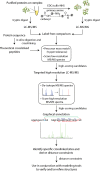Probing large conformational rearrangements in wild-type and mutant spectrin using structural mass spectrometry
- PMID: 24453214
- PMCID: PMC3918770
- DOI: 10.1073/pnas.1317620111
Probing large conformational rearrangements in wild-type and mutant spectrin using structural mass spectrometry
Abstract
Conformational changes of macromolecular complexes play key mechanistic roles in many biological processes, but large, highly flexible proteins and protein complexes usually cannot be analyzed by crystallography or NMR. Here, structures and conformational changes of the highly flexible, dynamic red cell spectrin and effects of a common mutation that disrupts red cell membranes were elucidated using chemical cross-linking coupled with mass spectrometry. Interconversion of spectrin between closed dimers, open dimers, and tetramers plays a key role in maintaining red cell shape and membrane integrity, and spectrins in other cell types serve these as well as more diverse functions. Using a minispectrin construct, experimentally verified structures of closed dimers and tetramers were determined by combining distance constraints from zero-length cross-links with molecular models and biophysical data. Subsequent biophysical and structural mass spectrometry characterization of a common hereditary elliptocytosis-related mutation of α-spectrin, L207P, showed that cell membranes were destabilized by a shift of the dimer-tetramer equilibrium toward closed dimers. The structure of αL207P mutant closed dimers provided previously unidentified mechanistic insight into how this mutation, which is located a large distance from the tetramerization site, destabilizes spectrin tetramers and cell membrane integrity.
Keywords: hereditary hemolytic anemia; protein conformations.
Conflict of interest statement
The authors declare no conflict of interest.
Figures





References
-
- Herzog F, et al. Structural probing of a protein phosphatase 2A network by chemical cross-linking and mass spectrometry. Science. 2012;337(6100):1348–1352. - PubMed
Publication types
MeSH terms
Substances
Grants and funding
LinkOut - more resources
Full Text Sources
Other Literature Sources

